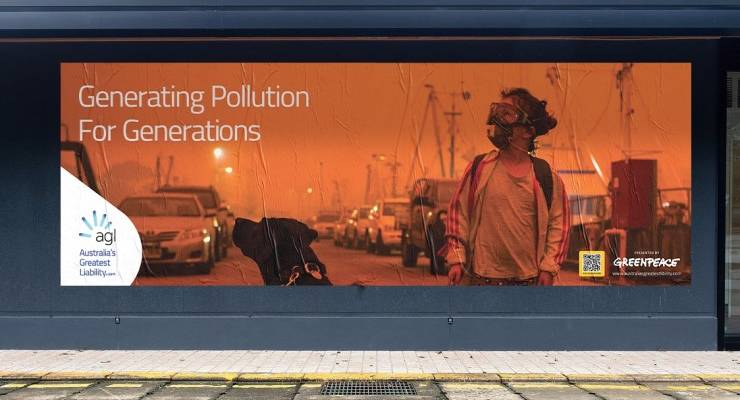
Corporations, being inanimate, have no soul. So I don’t know why people keep expecting them to have a sense of humour. AGL certainly doesn’t.
Greenpeace has been targeting AGL recently, following its identification (via official data) that the company is currently responsible for 8% of Australia’s total carbon emissions — that’s a whopping 42.2 million tonnes in 2019-20, nearly 25% of the total for the whole electricity sector.
AGL used to be short for Australian Gas Light, but these days it’s better known as the owner of three massive, ancient coal-fired power stations at Liddell and Bayswater in NSW and Loy Yang A in Victoria. In fact, 85% of the electricity AGL generates comes from coal.
As Greenpeace points out, there’s rather a contrast between how AGL likes to describe itself and the dirty reality. A quick visit to AGL’s website tells us that the company is “working with our stakeholders to shape a sustainable energy future for Australia”.
On the “How we source energy” page, there’s information about solar, wind, hydroelectric and natural gas, but what about coal? It’s there, they just call it “Thermal” and shove it down the page.
Greenpeace’s campaign is calling on AGL to get serious about renewable energy, and for consumers to get educated about what’s going on behind the marketing spin.
AGL is not amused, and has launched Federal Court proceedings to communicate its displeasure. It can’t sue Greenpeace for being mean to it; big corporations cannot be defamed.
And it can’t sue Greenpeace for lying, not just because Greenpeace isn’t lying, but because the misleading or deceptive conduct prohibition in the consumer law only applies to conduct “in trade or commerce”. As is well-established, environmental activism isn’t that. It’s why the Coalition parties repeatedly try to bring in new laws criminalising legitimate protest activity, but that’s another story.
Not to be discouraged by the absence of a viable cause of action, AGL is suing Greenpeace over the use of its corporate logo. Greenpeace has deployed the logo in its campaign material, using it for parody purposes to highlight its point. For example, it displays the logo with the words “AGL — Australia’s Greatest Liability”. Okay, no marks for creativity, but that’s not AGL’s complaint.
What AGL is claiming is that Greenpeace’s use of its logo constitutes an infringement of both its registered trademark and copyright owned by it. That is, the copyright in the logo as an original artwork.
There has already been a preliminary stoush in court, with AGL seeking an urgent injunction to stop Greenpeace from using its logo. That failed, so the case will go on to a full hearing.
A logo can be both a trademark (what we lawyers call a “badge of trade”) and subject to copyright. Trademarks are registered, and it is the registration that gives you ownership and exclusivity. Copyright “subsists”, that is it comes into existence as soon as the thing is created. Any creative work can have copyright: writing, music, art, photos, recordings, computer programs etc. The copyright in the AGL is in its form as a piece of art.
Does AGL have a case? Nah, they’re pushing shit uphill, to use a legal phrase.
The trademark case is hopeless. Common misunderstanding about trademarks: you can’t infringe unless you’re using someone else’s registered trademark “as a trademark”, meaning to identify goods or services that aren’t those of the registered owner. But if you’re applying it to identify the genuine article, then no issue. You don’t need the owner’s permission.
As for copyright, AGL first has to prove that it is the owner of the copyright in its logo. Not necessarily as obvious as it sounds; the original owner of the copyright will have been the artist who drew it. Corporates often fall down on the technical proof of ownership. But maybe they have that sorted.
If AGL does own the copyright, then any unauthorised reproduction of the logo would be an infringement. Unless Greenpeace has a good defence.
Greenpeace has indicated its defence will be parody or satire, under the Copyright Act. There’s not much law on that — the idea is that it’s a “fair dealing”, and therefore not an infringement, of someone else’s copyright work if you’re just using it to make fun of it (or something else).
The essence of the parody defence is that you have to have added something extra to the original copyrighted work, which makes it funny. Now, maybe the lameness of Greenpeace’s comedy writing will count against it, but I don’t think that the issue of whether a use qualifies as parody or satire should be dependent on how objectively funny it is.
Clearly Greenpeace is taking the piss, bringing it neatly within the intention that the then-attorney-general referenced when he introduced the parody defence into the act in 2006: that it would “promote free speech and Australia’s fine tradition of satire”.
If the law turns out to be on AGL’s side on this question, then comedy is dead.








Thank you for again “translating” legalese(is this a word?) into understandable English.
It was Tom Lehrer that suggested Henry Kissinger’s award of the Nobel Prize for Peace in 1973 threatened the death of satire.
AGL also seems to be wanting to see an end to satire in its legal suit against Greenpeace as Michael Bradley points out. Last year I produced some graphics that satirised Woolworths in its dastardly venture in creating the largest grog shop in the southern hemisphere here in Darwin. The graphics used the Dan Murphy’s logo in the satirical criticism. At least one non-for-profit news web site that posted the images “out of an excess of caution” (there’s a lot of that in these pandemic days), received legal advice to pull the images down.
Oh well. I didn’t pull them down, and Woolworths has ultimately decided to withdraw its bid for a Dan Murphy’s. Maybe they got a laugh out of the graphics. Maybe it was something to do with their social licence to operate. Who knows?
Anyway. Bradley suggests that Greenpeace, in adapting AGL’s title as “Australia’s Greatest Liability”, is satirical but not wildly funny. I agree. A suggestion: perhaps Crikey should run a competition for the best and funniest interpretation of the AGL initialisation? Australia’s Greenwashing Liars? Australia’s Greediest Litigants? Go for it! Happy to be a co-judge with Mr Bradley on selecting the funniest/most satirical version!
Love your work. I still have a print of Pauline Hanson morphing slowly into a crocodile Warhole style. Good to hear that Woolworths lost the battle to build the grog shop. The right decision. Rare, these days…..
Hey, this Australia, the law will bend over backwards to find the case for AGL. It’s what they pay all those ‘donations’ for afterall.
And if AGL don’t win, we can expect to see a bill in parliament addressing the issue very soon
Who’s guilty? AGL or the people who buy their product? Both? Or the people who shovel the coal? The various governments that allow this crap?
Whatever, just shut the stupid bastard things down. Go green. It is an imperative.
“Truth in advertising”? It’ll never catch on.